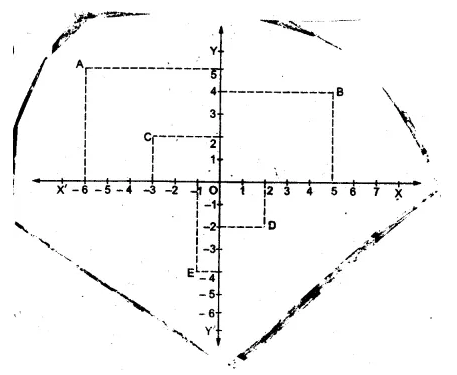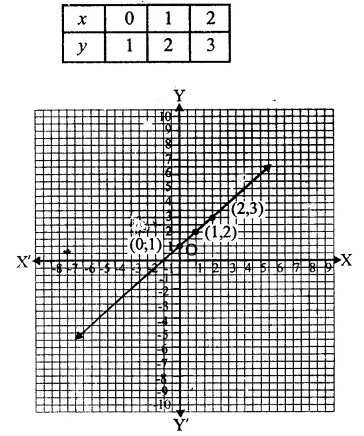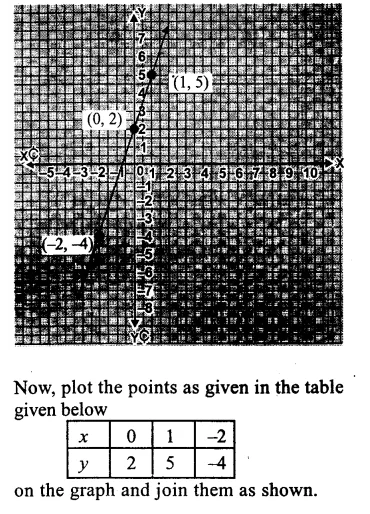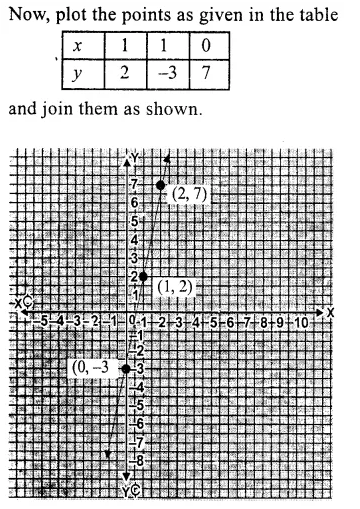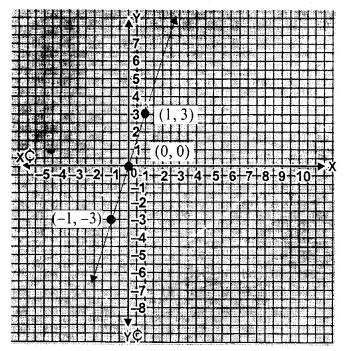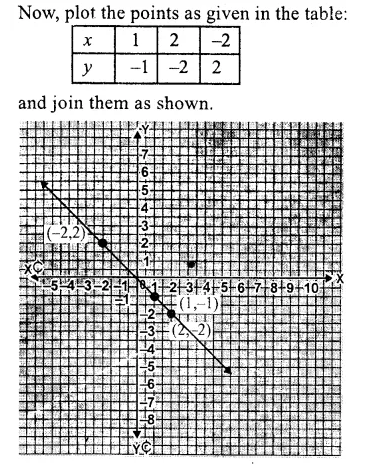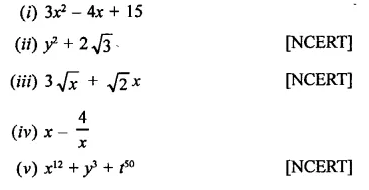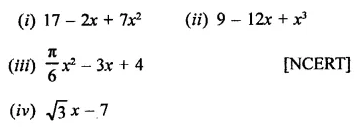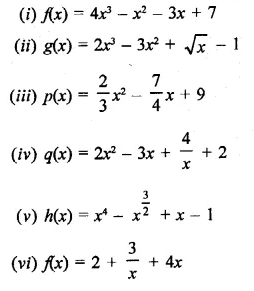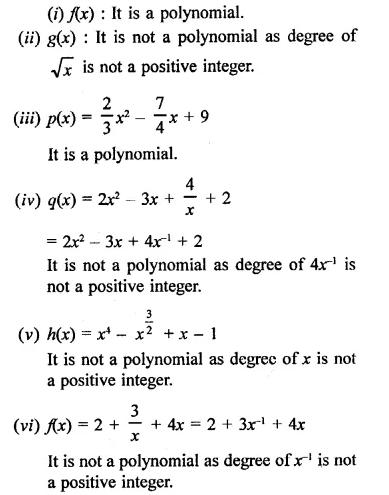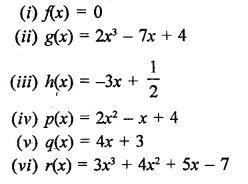RD Sharma Class 9 Solutions Chapter 6 Factorisation of Polynomials Ex 6.2
These Solutions are part of RD Sharma Class 9 Solutions. Here we have given RD Sharma Class 9 Solutions Chapter 6 Factorisation of Polynomials Ex 6.2
Other Exercises
- RD Sharma Class 9 Solutions Chapter 6 Factorisation of Polynomials Ex 6.1
- RD Sharma Class 9 Solutions Chapter 6 Factorisation of Polynomials Ex 6.2
- RD Sharma Class 9 Solutions Chapter 6 Factorisation of Polynomials Ex 6.3
- RD Sharma Class 9 Solutions Chapter 6 Factorisation of Polynomials Ex 6.4
- RD Sharma Class 9 Solutions Chapter 6 Factorisation of Polynomials Ex 6.5
- RD Sharma Class 9 Solutions Chapter 6 Factorisation of Polynomials VSAQS
- RD Sharma Class 9 Solutions Chapter 6 Factorisation of Polynomials MCQS
Question 1.
If f(x) = 2x3 – 13x2 + 17x + 12, find
(i) f (2)
(ii) f (-3)
(iii) f(0)
Solution:
f(x) = 2x3 – 13x2 + 17x + 12
(i) f(2) = 2(2)3 – 13(2)2 + 17(2) + 12
= 2 x 8-13 x 4+17 x 2+12
= 16-52 + 34 + 12
= 62 – 52
= 10
(ii) f(-3) = 2(-3)3 – 13(-3)2 + 17 x (-3) + 12
= 2 x (-27) – 13 x 9 + 17 x (-3) + 12
= -54 – 117 -51 + 12
= -222 + 12
= -210
(iii) f(0) = 2 x (0)3 – 13(0)2 + 17 x 0 + 12
= 0-0 + 0+ 12 = 12
Question 2.
Verify whether the indicated numbers are zeros of the polynomials corresponding to them in the following cases: [NCERT]
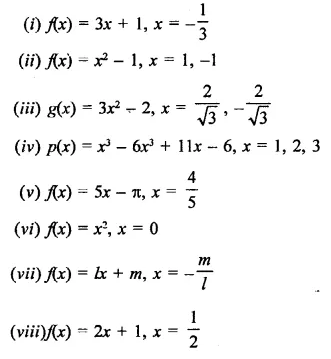
Solution:
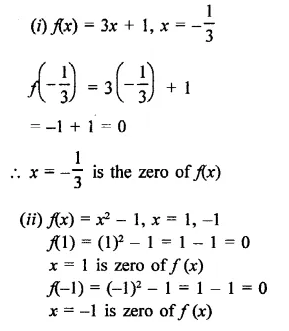
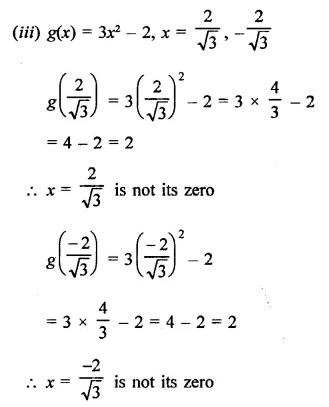
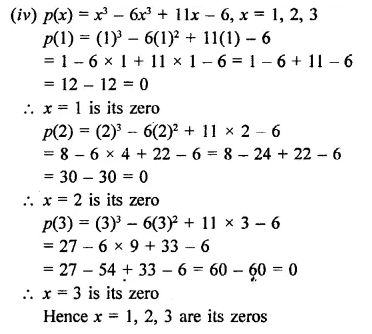

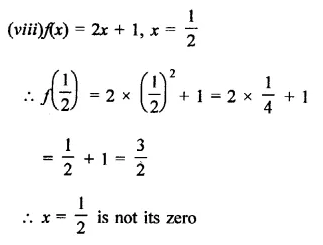
Question 3.
If x = 2 is a root of the polynomial f(x) = 2x2-3x + la, find the value of a.
Solution:
p(x) = 2x2 – 3x + 7a
∵ x = 2 is its zero, then
p(0) = 0
∴ p( 2) = 2(2)2 – 3×2 + la = 0
⇒2 x 4-3 x2 + 7a = 0
⇒ 8 – 6 + 7o = 0
⇒2 + 7a = 0
⇒ 7a = -2 ⇒ a =\(\frac { -2 }{ 7 }\)
∴ Hence a = \(\frac { -2 }{ 7 }\)
Question 4.
If x = –\(\frac { 1 }{ 2 }\) is a zero of the polynomial p(x) = 8x3 – ax2 – x + 2, find the value of a.
Solution:
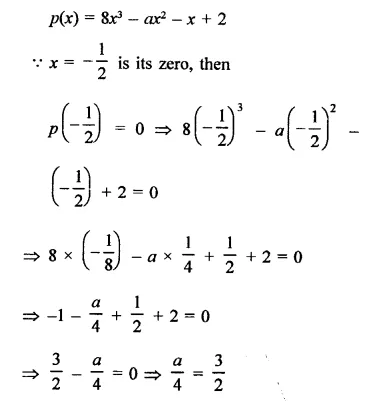

Question 5.
If x = 0 and x = -1 are the roots of the polynomial f(x) = 2x3 – 3x2 + ax + b, find the value of a and b.
Solution:
f(x) = 2x3 – 3x2 + ax + b
∵ x = 0 and x = -1 are its zeros
∴ f(0) = 0 and f(-1) = 0
Now, f(0) = 0
⇒ 2(0)3 – 3(0)2 + a x 0 + b = 0
⇒ 0-0 + 0 + b= 0
∴ b = 0
and f(-1) = 0
⇒ 2(-1)3 – 3(-1)2 + a(-1) + b = 0
⇒ 2 x (-1) – 3 x 1 + a x (-1) + b = 0
⇒ -2 -3-a + b = 0
⇒ -2-3-a + 0 = 0
⇒ -5- a = 0=>a =-5
Hence a = -5, b = 0
Question 6.
Find the integral roots of the polynomial f(x) = x3 + 6x2 + 11x + 6.
Solution:
f(x) = x3 + 6x2 + 11x + 6
Construct = 6 = ±1, ±2, +3, ±6
If x = 1, then
f(1) = (1)3 + 6(1)2 + 11 x 1 + 6
= 1+ 6+11+ 6 = 24
∵ f(x) ≠ 0, +0
∴ x = 1 is not its zero
Similarly, f(-1) = (-1)3 + 6(-1)2 + 11(-1) + 6
= -1 + 6 x 1-11+6
=-1+6-11+6
= 12-12 = 0
∴ x = -1 is its zero
f(-2) = (-2)3 + 6(-2)2 + 11 (-2) + 6
= -8 + 24 – 22 + 6
= -30 + 30 = 0
∴ x = -2 is its zero
f(-3) = (-3)3 + 6(-3)2 + 11 (-3) + 6
= -27 + 54 – 33 + 6 = 60 – 60 = 0
∴ x = -3 is its zero
x = -1, -2, -3 are zeros of f(x)
Hence roots of f(x) are -1, -2, -3
Question 7.
Find the rational roots of the polynomial f(x) = 2x3 + x2 – 7x – 6.
Solution:
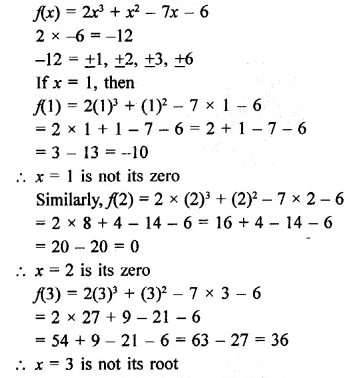
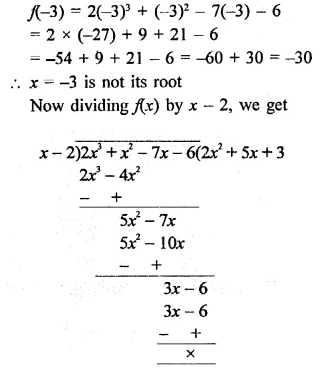
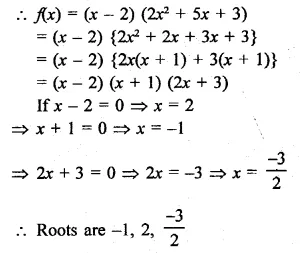
Hope given RD Sharma Class 9 Solutions Chapter 6 Factorisation of Polynomials Ex 6.2 are helpful to complete your math homework.
If you have any doubts, please comment below. Learn Insta try to provide online math tutoring for you.
